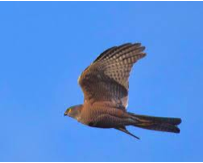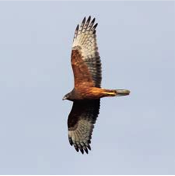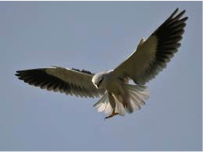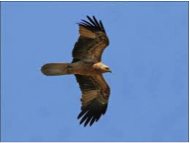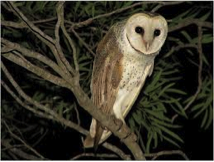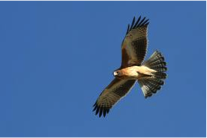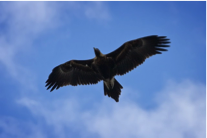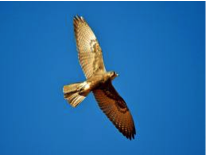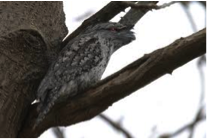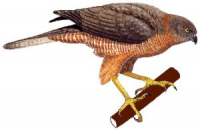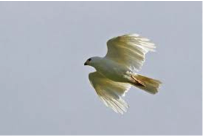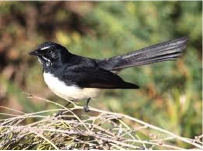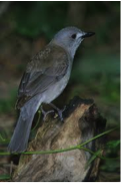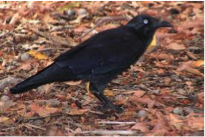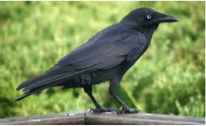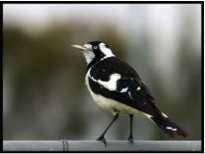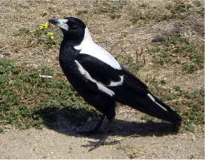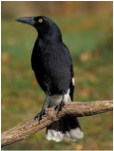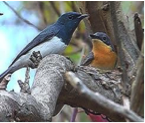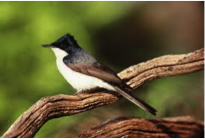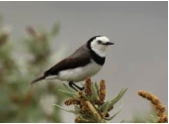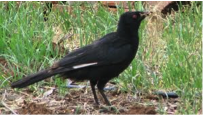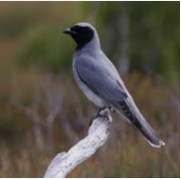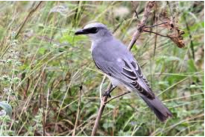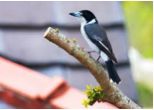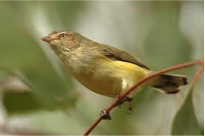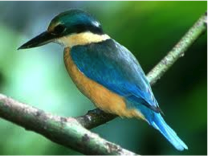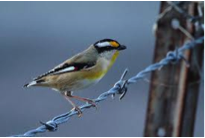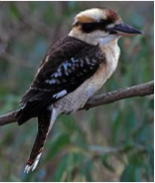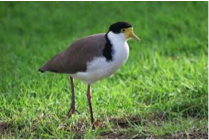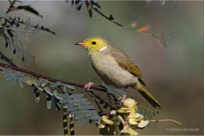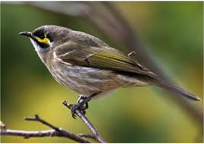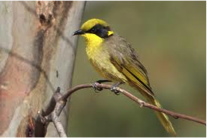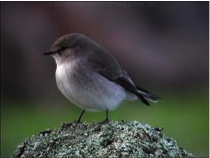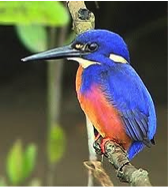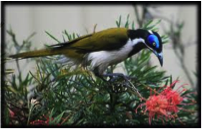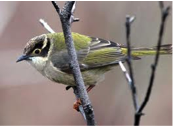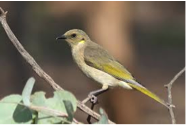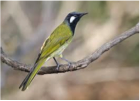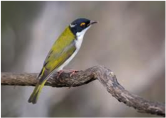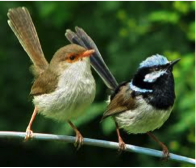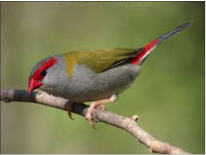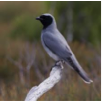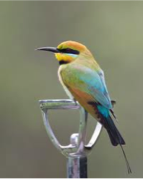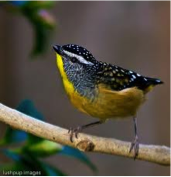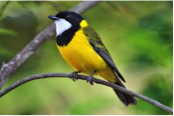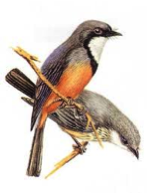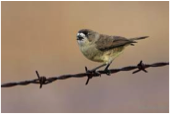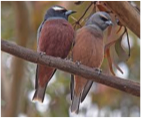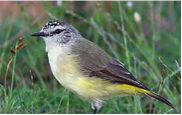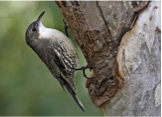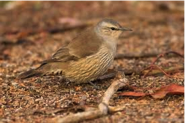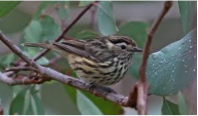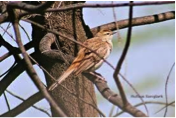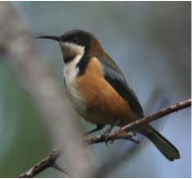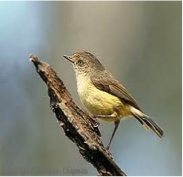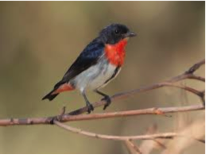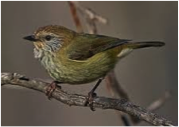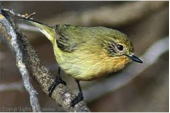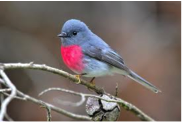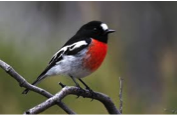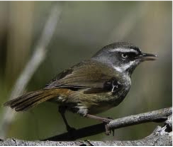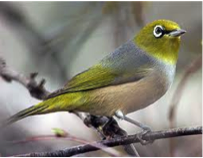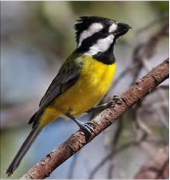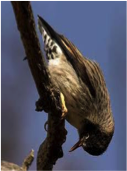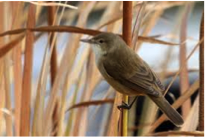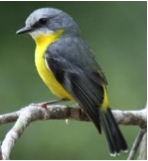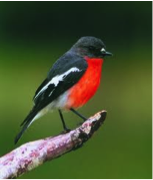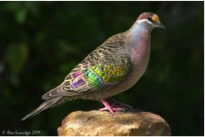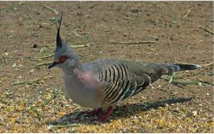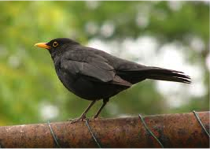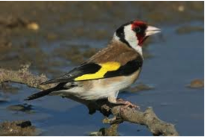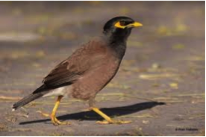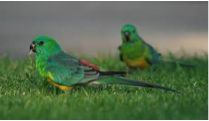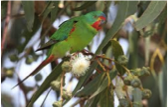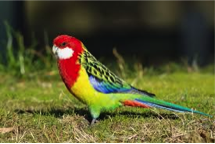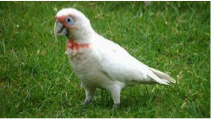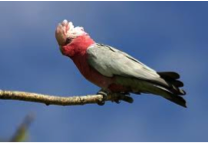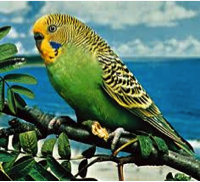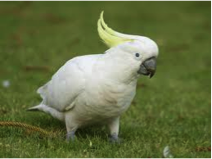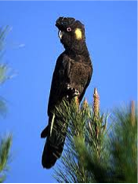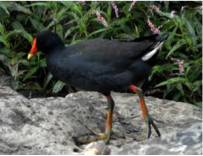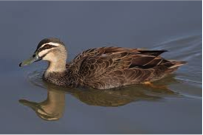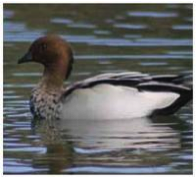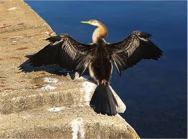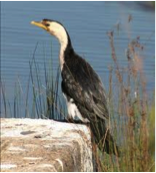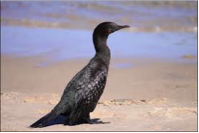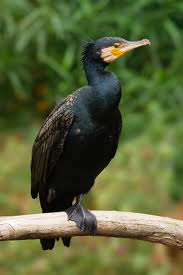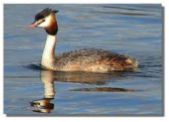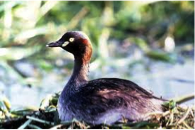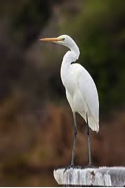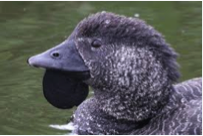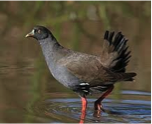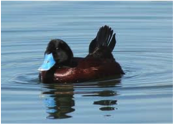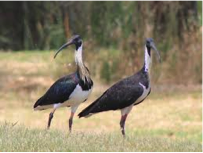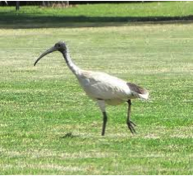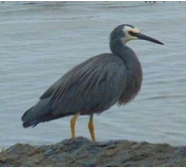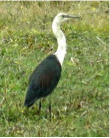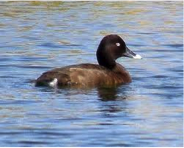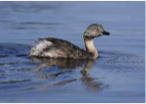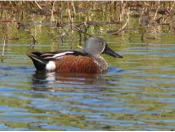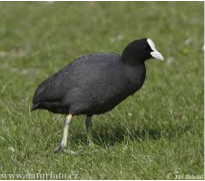Birds found in Sedgwick, North Harcourt and surrounding districts
The Australian Owlet-nightjar is the smallest of the nocturnal birds found in Australia. Its long tail distinguishes it from owls. Its large brown eyes are non-reflective when exposed to a torch or spotlight (other nocturnal birds give a red reflection). Plumage is grey, paler below, and faintly barred with black. There are two wide black stripes that extend over the head from the top of the eyes, and meet on the back of the neck.
The Collared Sparrowhawk is a medium-sized, finely built raptor (bird of prey) with wide staring bright yellow eyes. The upperparts and side of the head are slate-grey, with a complete chestnut half-collar. The underparts are finely barred pale rufous on white and the rounded wings are rather short. The bill is black, with a pale yellow cere (fleshy bill base). The Collared Sparrowhawk has long fine yellow legs and very long toes, especially the middle toe. The tail is long and generally squared at the tip. The sexes are similar in appearance but males are smaller than females. The Collared Sparrowhawk is also called the Chickenhawk.
The Swamp Harrier is a large slim-bodied raptor, with long slender legs and a long tail, rounded at the tip. It is mainly dark brown above and the white rump is prominent. It has an owl-like face mask. The wings are long and broad, with 5 ‘fingers’ on the wing tips in flight. The legs and eyes are yellow. This species has a slow sailing flight on up-swept wings, flying low over water.
The Nankeen Kestrel is a slender falcon and is a relatively small raptor. The upper parts are mostly rufous, with some dark streaking. The wings are tipped with black. The underparts are pale buff, streaked with black, and the under tail is finely barred with black, with a broader black band towards the tip. Females tend to be more heavily marked and have more rufous on the crown and tail. Males have a greyish crown and tail, although the extent varies between individuals. Hovers over grassland
Black-shouldered Kites are medium raptors, and are mostly pale grey above, with a pure white head, body and tail and black shoulders. The wings are white underneath, with dark wing tips. The red eye is marked by a black comma that extends behind it. The nostrils are yellow and the legs and feet are also yellow. The Black-shouldered Kite has a direct flight with quick shallow wing beats interspersed with glides on upswept wings, and is often seen hovering, with feet dangling.
The Whistling Kite is a medium-sized raptor with a shaggy appearance. It has a light brown head and underparts, with pale streaks, and dark sandy-brown wings with paler undersides. The underwings have dark trailing edges and dark wingtips. The head and body are relatively narrow and the tail is long and rounded. The wings are long and well-rounded. They are often seen near water or around farms, soaring in a lazy circling flight pattern.
The Barn Owl is a pale, long-winged, long-legged owl with a short squarish tail. Flies with wavering motions and open dangling feathered legs. It has a light heart-shaped facial disc and black eyes. Upper parts are usually light brown, with fine black and white speckles. The underparts are much paler. It produces the characteristic shree scream, ear-shattering at close range.
The Powerful Owl is a large owl with a relatively small head and a rounded tail. It is dark grey to dark grey-brown above, with white barring, and off-white below, with distinctive dark chevrons. The eyes are yellow, set in a dark grey/brown facial mask. The legs are feathered and the yellow to orange feet are massive, with sharp talons. The sexes are alike but the female is smaller, with a narrower head.
The Little Eagle is a small, powerful stocky eagle, with a short broad head and moderately long tail, square-cut at the tip when closed. The legs are heavily feathered. When perched, the Little Eagle has a short crest. Plumage varies from light to dark brown, with a pale broken ‘M’ across the upperparts, which is visible from a distance. It has long broad wings, spanning over 1m, with dark ‘fingered’ tips. The underwings have dark leading and trailing edges. It soars in tight circles, very high on thermals or up-draughts, gliding on flat wings. The female is larger than the male.
The Wedge-tailed Eagle has long wings (wingspan 2.3 m), a characteristic long, wedge-shaped tail, and legs that are feathered all the way to the base of the toes. The bill is pale pink to cream, the eye brown to dark brown, and the feet off-white. Young Wedge-tailed Eagles are mid brown in colour with reddish-brown heads and wings. They become progressively blacker for at least the first ten years of their lives; adults are mostly dark blackish-brown. The only difference in plumage between the sexes is that a female adult is generally slightly paler than her mate. Females (4.2 kg – 5.3 kg) are also larger and heavier than males (3.2 kg up to 4.0 kg). Wedge-tailed Eagles are Australia’s largest raptors (birds of prey).
Brown Falcons are small to medium-sized raptors. The female is larger than the male. The Brown Falcon has a range of plumage colours, from very dark brown to light brown above and off-white below. Generally, the upperparts are dark brown and the underparts are pale buff or cream. The sides of the head are brown with a characteristic tear-stripe below the eye. Younger birds resemble dark adults, but have less obvious barring on the tail, and a buff-yellow colour on the face, throat and nape of the neck.
The general plumage of the Tawny Frogmouth is silver-grey, slightly paler below, streaked and mottled with black and rufous. The eye is yellow in both forms, and the wide, heavy bill is olive-grey to blackish. Tawny Frogmouths are nocturnal birds. During the day, they perch on tree branches, often low down, with a rigid branch-like posture.
Brown Goshawks are medium-sized raptors. They have a brown head, slate-grey to brown upperparts with a red-brown collar across the upper nape of the neck, and finely barred underparts of red-brown with white. The rounded wings are dark brown to grey above and buff to reddish brown below with darker wingtips, and the long rounded tail is grey with dark bars. The long legs are yellow, with reddish brown feathering about the thighs. The eye is bright yellow, with a beetle-brow. Males are smaller than females. Young birds have grey-brown eyes, with brown, streaky plumage.
The Grey Goshawk is a medium-sized, stocky raptor, with two colour forms. The grey form has a grey head and upperparts, with white underparts barred grey on the chest. The rounded wings are grey above, white below, and have darker wingtips. The medium length tail is grey above and white below, barred grey. The white form is pure white all over and is often known as the White Goshawk. Both forms have a dark red eye and yellow legs and feet.
The Southern Boobook is the smallest and most common owl in Australia. It is identified by its plumage, which is dark chocolate-brown above and rufous-brown below, heavily streaked and spotted with white. The bill is grey with a darker tip, and the feet are grey or yellow. The facial disc is chocolate brown and the eyes are large and yellowish. Young Southern Boobooks are almost entirely buff-white below, with conspicuous dark brown facial discs. Like other owl species, the Southern Boobook is nocturnal. Birds are often observed perched on an open branch or tree-top. It is also known as the ‘Mopoke’.
The Willie Wagtail is the largest, and most well-known, of the Australian fantails. The plumage is black above with a white belly. The Willie Wagtail can be distinguished from other similar-sized black and white birds by its black throat and white eyebrows and whisker marks. The name wagtail stems from the constant sideways wagging of the tail. Young birds resemble the adults, but have paler, slightly rusty edges to the feathers of the wings.
The Grey Shrike-thrush is a rather drab coloured bird, although the plumage varies throughout its extensive range. Birds are mostly grey, with an olive-grey back, and pale grey-white cheeks and underparts. Adult males are browner on the mantle than the female and young birds have varying amounts of rufous on the cheeks and wings. Males have a black bill and white lores (between the bill and the eye). Glorious song.
Australian Ravens are black with white eyes in adults. The feathers on the throat (hackles) are longer than in other species, and a bird tends to extend these when calling, while holding its head and body in a horizontal position. Australian Ravens are usually seen in pairs. Another aid to identification of this species is the absence of wing-flicking while calling. Young birds resemble the adults, but have dark eyes, shorter throat hackles and often the presence of a pink, fleshy gape. This species is sometimes incorrectly called a crow. Long wailing call.
Some of the differences between the two species are as follows: the Little Raven is, at about 48–50 cm in length on average, somewhat smaller than the Australian Raven (though sizes do overlap between both species), the Little Raven’s beak is slightly smaller and more curved, its calls are shorter, and its throat bulges out less while calling. The Little Raven is a somewhat more sociable species than the Australian Raven, often forming large flocks that roam freely over wide areas in search of food. The range of the Little Raven does overlap the range of the Australian Raven, but the latter’s range extends further.
The Pied Currawong is a large, mostly black bird, with a bright yellow eye. Small patches of white are confined to the under tail, the tips and bases of the tail feathers and a small patch towards the tip of each wing (visible in flight). The bill is large and black and the legs are dark grey-black. Both sexes are similar, although the female may sometimes be greyer on the underparts. Young Pied Currawongs are duller and browner than the adults. Longer and more melodious call than the grey currawong.
The Leaden Flycatcher is a small bird, mainly dark blue grey above and white below, with a small crest and a broad black-tipped blue bill surrounded by small bristles. Males have entirely dark blue-grey upperparts, head and chest, while females have a blue-grey head and back with a distinctive orange buff chin, throat and breast merging gradually into white lower parts. Characteristic quivering of tail on alighting.
The Restless Flycatcher has a glossy blue-black head, with a small crest, and is white below from the chin to the undertail, with a blue-black bill surrounded by bristles. The back, wings and tail are darker grey and there may be a slight orange brown tint on the breast. The Restless Flycatcher is an extremely mobile and active bird and is able to hover while feeding, uttering a grinding call.
Male White-fronted Chats have a white face, breast and belly, dissected by a distinctive black band across the breast that extends around to the back of the head. Females have similar markings but they are gradations of grey-brown, rather than black-white, and the breast band is narrower. Immatures are similar to the female, but the breast band is very faint or missing.
The White-winged Chough is a large, almost completely black bird. It has a curved beak, a red eye and a large white wing patch, which is seen when the bird is in flight. The bill and legs are black. Both male and female share the same plumage pattern. Young White-winged Choughs start off duskier than the adults, and the eye is brown. They do not reach sexual maturity until four years of age and, during this time, the eye changes from brown to orange and then to red, and the plumage darkens.
Blue/grey bird with white underparts and darker grey flight and tail feathers, white tip to tail. Black bill with short black mask joining the dark eye, and fine white rear eye-ring. Legs black. Juvenile birds have faint barring on the breast and the back is mottled. Undulating flight, with long glides alternating with bursts of wing beats, then distinctive shuffling and folding of wings on landing. Found singly or in pairs.
The adult Grey Butcherbird has a black crown and face and a grey back, with a thin white collar and white throat. The wings are grey, with large areas of white and the underparts are white. The grey and black bill is large, with a small hook at the tip of the upper bill. The eye is dark brown and the legs and feet are dark grey. Both sexes are similar in plumage, but the females are slightly smaller than the males. Young Grey Butcherbirds resemble adults, but have black areas replaced with olive-brown and a buff wash on the white areas. The bill is completely dark grey and often lacks an obvious hook.
The Weebill’s common name comes from the short, stubby, pale beak. The eye is pale cream, and there is a pale line above the eye. Weebills are dull grey-brown on the head and olive-brown on the back, and the underparts are buff to yellow. Both sexes are similar in colouration, and young birds can be separated from the adults by their greyer eye. May be seen hovering on the outer edges of the canopy.
The Striated Pardalote varies in plumage characteristics across its range. All birds have white eyebrows with a yellow spot in front of the eye, olive-grey backs and a white stripe in the wing. The coloured spot at the front end of this stripe may be red or yellow. The black crown has fine white stripes. Both male and female are similar in plumage. Short black bill.
The Australasian Pipit is a well-camouflaged brown ground-dwelling bird. It has darker brown streaks above, and has pale creamy white stripes on the eyebrows and below the cheeks. The underparts are creamy white, spotted and streaked dark on the breast. The wings and tail are dark brown, with the outermost tail feathers white. The eye is brown and the bill and feet are pale pink-grey. Seen on the ground in open country, this species often wags its tail up and down while foraging. It was previously called Richard’s Pipit.
The Laughing Kookaburra is instantly recognisable in both plumage and voice. It is generally off-white and faintly barred below, with a dark brown back, and light blue scallops on the wings. The tail is more rufous, broadly barred with black. There is a conspicuous dark brown eye-stripe through the face. It is one of the larger members of the kingfisher family. Raises its tail on alighting.
Masked Lapwings are large, ground-dwelling birds. They are mainly white below, with brown wings and back and a black crown. Birds have large yellow wattles covering the face, and are equipped with a thorny spur that projects from the wrist on each wing. The spur is yellow with a black tip. Aggressive when nesting.
The Tree Martin has a shallowly forked tail. The adult has an iridescent blue back and crown, brown wings and tail, a deep buff forehead and a dull white rump. The underparts are white. This species can be distinguished from Australian swallows by its tail shape and pale rump. The most similar species, the Fairy Martin, has a rufous head and nape.
The White-plumed Honeyeater is a medium-sized honeyeater with a slightly down-curved bill. It is yellowish-olive to grey above, pale brown-grey below, with a yellowish head and a distinctive white neck-plume, giving the bird its name. Usually gregarious and seen constantly moving from tree to tree with rapid darting movements.
The Yellow-faced Honeyeater is a medium to small, plainly coloured honeyeater with a slightly down-curved bill. It is dark grey-brown above, with some brown streaking on the head, and paler below with lighter streaks. It has a distinctive, broad yellow face-stripe, bordered with black. It can be seen in large flocks when migrating, and in smaller groups when feeding.
The Azure Kingfisher is a small kingfisher with a long slender black bill and a short tail. The head, neck, upper parts and breast sides are deep azure blue with a violet (purplish) sheen. The neck has a distinctive orange stripe on each side and there is a small orange spot before each eye. The throat is pale orange-white, grading to orange-rufous on belly and undertail. The flanks and sides of the breast are washed purple to violet. The legs and feet are red.
The Blue-faced Honeyeater is a large black, white and golden olive-green honeyeater with striking two-toned blue skin around the yellow to white eye. The crown, face and neck are black, with a narrow white band across the back of the neck. The upperparts and wings are a golden olive green, and the underparts are white, with a grey-black throat and upper breast. Juvenile birds are similar to the adults but the facial skin is yellow-green and the bib is a lighter grey. This honeyeater is noisy and gregarious, and is usually seen in pairs or small flocks.
Males and females have an olive-green head and back, grey wings and tail, and cream underparts, boldly streaked with brown. They both have a bright red eye and reddish beak. Females can be distinguished from males by a paler bill, duller-green back, and an extension of the streaked underparts up to the chin.
The Brown-headed Honeyeater is a small honeyeater with a short slender bill. It is plain olive green above, with a brown head marked by a pale crescent at the nape, and is pale grey to buff below. It has a creamy yellow to orange eye-ring which completely encircles the dark eye. This species is usually seen in flocks of five to fifteen birds foraging high in the tree canopy.
The Fuscous Honeyeater is a medium-small ‘plain’ olive-brown honeyeater with an unmarked face, apart from a slightly darker colouring around the eye. It has a small, indistinct yellow neck plume bordered black. The eye is brown. The eye ring and base of bill are yellow out of breeding season and dark during breeding. The slightly curved bill is medium-sized.
The White-eared Honeyeater has a strong bill. It is olive-green above with lighter green underparts. It has a grey cap, a black face and bib (under bill) with a distinctive, contrasting white ear-patch. The sexes are similar in plumage but the males are larger. Young are duller and browner. Quite noisy and conspicuous.
The White-naped Honeyeater is a small honeyeater with a short, slender bill. It is olive-green above, with a black cap, a white band across the back of the neck which does not reach the eye, and a bright orange-red crescent above the eye. The flanks and sides of the breast are washed grey brown and the underparts are white. It can be seen in large flocks when migrating, often with other honeyeaters, and in smaller groups when feeding.
Adult male Superb Fairy-wrens have rich blue and black plumage above and on the throat. Younger males go into eclipse plumage outside the breeding season. The belly is grey-white, the bill is black, and the tail dark blue. Females and young birds are mostly brown above with a dull orange-brown area around the eye and a brown bill. Females have a pale greenish gloss, absent in young birds, on the otherwise brown tail. The legs are brown in both sexes. All carry their long tails cocked up.
The Red-browed Finch is most easily recognised by its bright red eyebrow, rump and beak, on an otherwise green and grey bird. Upperparts are olive green with grey underneath. Both sexes are similar in appearance. Young birds have black bills. Often observed in small flocks, which feed on the grass. They will fly into dense undergrowth when disturbed by a passer-by.
The female is the larger and more coloured of these small, plump, well-camouflaged ground-dwellers. The overall colouration is grey, with large white spots on the breast which fade to off-white around the legs and vent. The face has small black-edged white spots with a white eye-brow. The wings and back of the female are mostly chestnut, with white spots and black, white-edged bars on the wing. The male is similar but the chestnut colur is replaced with buff.
The Fan-tailed Cuckoo is a slender cuckoo and the adult bird is easily identified by a yellow eye ring (slightly greenish in young birds), its generally dark slate-grey back and wings, becoming pale rufous below, with a boldly barred black and white under tail. Younger birds are duller and browner in colour. Mournful descending trill.
The Pallid Cuckoo is identified by its grey plumage, which is darker on the wings and back, and its broadly barred black and white undertail. The bill is brown, the legs and feet are grey-brown, and there is a bright yellow ring around the eye. It is a large, slender cuckoo and is somewhat hawk-like in appearance during flight. Young Pallid Cuckoos are mottled with brown and buff above, with a white spot on the nape, and are streaked with grey-brown and white below. As with other species of cuckoo, its call often betrays its presence long before it is seen.
The White-browed Babbler is a small dark brown-grey bird with a white throat, a white tipped tail and a long, pointed curved bill. It has a distinct white brow and dark eye stripe. The tail is long and graduated, with a rounded tip. It is a very active bird that is often found in noisy social groups.
A striking, colourful bird, the Rainbow Bee-eater is medium sized, with a long slim curved bill and a long tail with distinctive tail-streamers. It has a golden crown and a red eye set in a wide black stripe from the base of the bill to the ears, which is edged with a thin blue line. The throat is orange-yellow, with a broad black band separating it from a green breast. The upperparts are green, with the flight feathers coppery and black tipped. The underwings are bright copper-orange, with a black edge. The lower abdomen is blue. The tail is black, including the long tail streamers, with a blue tinge. Females have shorter, thicker tail streamers than males, but are otherwise similar. Young birds are duller and greener, lacking the black band on the chest and the long tail streamers.
Horsfield’s Bronze-Cuckoo is an olive-brown above with pale scaling and a bronze to green sheen on the back and upper tail. It has a prominent dark-brown eyestripe, with a contrasting white eyebrow stripe above, with both curving down the sides of the neck. The throat is white with fine dark mottling.The underbody is white to cream with dark-brown barring at the sides, with the bars joining in the middle on the upper breast only. The undertail is grey with brown and white barring at the tip and sides. The tail is edged rufous (orange-brown) and the undertail is rufous when spread. Juveniles are similar but duller with faint or no barring on sides of body. Distinctive call.
The Spotted Pardalote is a tiny bird that is most often high in a eucalypt canopy, so it is more often detected by its characteristic call. The wings, tail and head of the male are black and covered with small, distinct white spots. Males have a pale eyebrow, a yellow throat and an orange-red rump. Females are similar but have less-distinct markings. Short black bill.
This large swift has long curved wings and white markings. The plumage of the White-throated Needletail is predominantly grey-brown, glossed with green and the wings are long and pointed. The tail is short and square, with the protruding feather shafts giving a spiky appearance. The throat and undertail are white.
The adult male Golden Whistler is bright yellow on the underside, olive-green on the back and wings, and black on the head with a bright yellow collar. The throat is white, separated from the yellow chest by a broad black band. The bill and legs are black. Females lack bright plumage. They are generally grey above, with a pale olive tinge, and paler grey below, with a buff wash. The bill is dark brown and the legs grey-brown. The eye is red-brown in adults of both sexes. Young Golden Whistlers are rufous. As they mature, the plumage comes to resemble that of the female other than rufous edges to some wing feathers. These are later replaced as the bird matures.
The Brown Thornbill is a small bird, but is one of the medium-sized and more common of the thornbills. It has olive-brown to grey upperparts, with a warm rusty-brown forehead scalloped with paler markings. The rump has a rusty-brown patch, the tail is grey-brown with a black band and a pale tip, and the underparts are off-white, streaked blackish on the chin, throat and chest. The eye is dark red. The sexes are similar and young birds are only slightly different to adults, with a duller eye.
The Rufous Whistler is a stocky bird with a large head, short stubby bill and a narrow, relatively long tail with a square or slightly forked tip. The sexes differ, with the male dark-grey above with a white throat, black breast and a rufous underbody. Many males also have a black face mask (except in northern subspecies). Females are dull grey to brown, with streaked underparts. Young birds are much redder than adults and have heavily streaked underparts.
The Dusky Woodswallow is a smoky deep brown to grey bird. The wings are dark blue grey, edged white, the tail is black with a broad white tip and the underwings are silvery-white. The bill is blue tipped black and the eye is dark brown. Young birds are grey-brown, streaked and mottled buff to cream. This species moves in flocks of 10 to 30 birds, which cluster together to roost.
The White-browed Woodswallow is a dark bird with a distinctive white eyebrow. The face and chin are black, the upperparts are deep blue grey and the lower breast to undertail is a rich chestnut brown. The underwings and undertail are pale whitish-grey, with white tail tips. Females are duller than males, with a browner body and pink to fawn underparts. Young birds are mainly brown, mottled and streaked buff to cream, and lack the white brow. This species is colonial and travels in large flocks that roost together in tight clusters.
The Yellow-rumped Thornbill is the largest and probably the best-known thornbill, with a striking yellow rump. It is mainly grey-olive to grey-brown above to cream below, with a white-spotted black crown and a dark eye stripe. The tail is black, with white tips. The sexes are similar. Young birds have softer, fluffier plumage on the body, but are otherwise similar. Often seen in small flocks feeding on the ground, often with other thornbills and ground-feeding birds.
The White-throated Treecreeper is dark brown, with a distinctive white throat and chest, and white streaks on its flanks, edged with black. The wings have a rufous bar that is visible in flight and the undertail is barred. The female has an orange mark on the sides of the face. Like other treecreepers, spends most of its time foraging up tree trunks and has a short, spiralling flight.
The Brown Treecreeper is the largest of Australia’s treecreepers. It is mostly pale brown in plumage. The head, throat and upper breast are pale greyish-brown, while the lower breast and belly are strongly streaked with black and buff. In flight, a buff stripe can be seen in the wing. The sexes are similar, except females have rufous edges to the feathers of the upper breast, while in the male these edges are black. Young Brown Treecreepers resemble the adults, but are duller, have less obvious stripes on the underparts and the lower belly is a pale rufous colour. Despite their name, they feed mostly on or near the ground.
The crown of the Speckled Warbler is black with buff streaks. Between the crown and the white eyebrow is a line that is black in the males and chestnut in the females, the only difference between the two. The dark red eye is prominent in the pale face. The back is mottled dark brown but the underparts are cream with bold black streaks. When it flies, its tail shows a black band with a white tip.
The Red Wattlebird is a large, noisy honeyeater. The common name refers to the fleshy reddish wattle on the side of the neck. The plumage is grey-brown on the body, with prominent white streaks and yellow on the belly. The face is pale and the tail is long with a white-tip. Young Red Wattlebirds are duller than the adult and have a brown, rather than reddish, eye. The wattle is also very small and pale.
The Rufous Songlark is a mid-brown, streaked bird with a rufous rump and upper tail, pale eyebrow and pale underparts, and a dark line through its eye. In the breeding season the melodious song of the male Rufous Songlark is heard almost continuously, both from perches and in slow display flights between trees. The male (about 19 cm) is larger than the female (about 16 cm).
The Eastern Spinebill is most easily recognised by its very long, fine, down-curved beak and energetic flight, during which its white outer tail feathers are prominent. Males have a grey-black crown which extends in a black line on either site of the breast. The breast and throat are white, with a rufous patch in the centre of the throat. The wings and lower back are dark grey and the underparts and upper back are buff. Females are similar to males but have less distinct markings.
The Welcome Swallow is metallic blue-black above, light grey below on the breast and belly, and rust on the forehead, throat and upper breast. It has a long forked tail, with a row of white spots on the individual feathers. The outer tail feathers (streamers) are slightly shorter in the female. Young Welcome Swallows are buffy white, instead of rusty, on the forehead and throat, and have shorter tail streamers.
Males have a glossy blue-black head, wings and upperparts, a bright red throat and chest, a white belly with a central dark streak and a bright red undertail. Females are grey above, white below, with a grey streak on the belly, and a pink undertail. These birds are swift and erratic fliers, moving singly or in pairs, usually high in or above the canopy.
The Striated Thornbill is a medium-sized thornbill with greenish upperparts, a copper cap, streaked distinctively with white and off-white to cream underparts, heavily streaked behind eyes, and on chin, throat and breast. The sexes are similar and young birds are only slightly different to adults, with less streaking on the underside.
The Yellow Thornbill is a small to medium-sized thornbill and is the most yellow of the thornbill group. It is greenish-olive on the back, with white streaking on the cheeks and ears, and has pale to bright yellow underparts. There is a rich tawny yellow tone on the chin and throat. The young birds are similar but duller.
The male Red-capped Robin is black above and white below with a distinctive scarlet-red cap, white shoulders, and a red breast that contrasts strongly with a black throat. The black wing is barred white and the tail is black with white edges. Females are quite different in appearance: grey-brown above and off-white below, with a reddish-brown forehead, brown-black wings barred buff to white, and some have faint red on the breast. Young birds are similar to females but are streaked white above, have an pale buff wing bar and their breast and sides are streaked or mottled dark-brown.
The Rose Robin is a slender robin with a relatively long tail. Males are dark grey above, with a small white patch above the bill (frontal patch), and have a rose-pink breast. The lower part of the underbody and outer tail feathers are white, the wings and upper tail dark grey. Females are mainly brown-grey above with a small white frontal patch, white outertail and wing bars, and off-white below, with occasional pale pink wash across breast. Young birds resemble females, but are streaked white above, usually lack the white frontal patch, and are mottled darked brown underneath, with less or no pink. Rose Robins are the most acrobatic of the red robin genus (Petroica) with a darting, tumbling flight, and forage higher up in the canopy.
The Scarlet Robin is a medium-sized robin, with a plump and compact appearance. Males have a black head, neck and upperparts with a conspicuous white patch above the bill (frontal patch). The breast is scarlet red and the lower underparts are white. The wings are barred white and the outer tail is also white. Females differ markedly from males, being brown above with a whitish frontal patch and an orange-red breast, brown wings and white underparts. Young birds resemble females but are streaked white above, tinged buff on the wings and are mottled dark-brown on the breast and sides of the body.
White-browed Scrubwrens are mostly dark olive-brown above, while the throat is buff grey and the flanks, belly and rump are dull rufous. They have a white line above the eye and another below the eye. There is a white chevron on the wing. The area around the eye between the lines is black, becoming greyer near the ear. The eye is light cream. Males and females are similar, but the females are slightly duller, particularly on the face. Young White-browed Scrubwrens are similar to the adults, but are generally duller, with more chocolate-brown backs and duskier faces.
The Silvereye is a small bird with a conspicuous ring of white feathers around the eye, and belongs to a group of birds known as white-eyes. The Silvereye shows interesting plumage variations across its range. The grey back and olive-green head and wings are found in birds through the east; Tasmanian birds have grey throats, chestnut flanks and yellow on the undertail, and may visit here in the winter.
The Crested Shrike-tit is a medium-small bird with a striking black and white striped head and neck, a small crest that is often held flattened over crown, a black throat, and a short heavy bill with hooked tips. It has wide, rounded wings and a square-tipped tail that can appear slightly forked. The species is separated into three geographically isolated subspecies. Males of the Eastern Shike-tit, frontatus, have an olive green back and rump, striking yellow underparts, with grey wings and tail. Females have a smaller head crest and an olive-green throat. Young birds have a pale throat and a brown back.
The Varied Sitella is a small, short-tailed, dumpy bird which is usually heard before it is seen in the upper branches. The iris is orange-yellow, and the eye-ring, legs and feet are yellow. The bill is long and slender and slightly up-turned. Adults are greyish above and white below, with varied streaking. The upper tail coverts are pale, with dark-barring underneath. The tail is dark with a white tip. The upper wings are dark; the underwings have an orange-rufous band. Males have longer bills than females and tend to feed lower. Sitellas are usually seen in flocks, moving swiftly between trees or foraging busily, head down, over branches or down the trunk.
The Brown Quail is a small, plump ground-dwelling bird. It is variable in colour, ranging from red brown to grey brown with fine white streaks and black barring above, and chestnut brown below. The eye is red to yellow, the bill black and the legs and feet orange-yellow. Female Brown Quails are larger and may be more heavily marked with black and paler below than males. Young birds are like adult females, with less distinct markings and a dark brown eye. Quails rarely fly, preferring to hide unless an intruder flushes them; then they fly low to the ground, with a rapid whirring flight.
The Australian Reed-Warbler is plain olive-brown above, with white underparts tinged buffy-cream, and has a pale orange-brown eyebrow. The sexes are similar. This species is more often heard than seen, but will be observed at times climbing among reeds and other water vegetation. Makes short low flights across water.
The Eastern Yellow Robin is a medium sized robin. It has a grey back and head, yellow underparts, and an olive-yellow rump. The throat is off-white and, in flight, there is a pale off-white wing bar. The bill is black. Both sexes are similar in plumage colour and pattern, but the female is slightly smaller. Young Eastern Yellow Robins are rufous-brown. The plumage has some paler streaks, which are confined to the wings when the birds are a little older. Distinctive piping call.
Male Flame Robins have a flame orange breast and throat, and are white on the lower belly and undertail. The top of their head and back is dark slate grey and there is a clear white stripe on the folded wing, and a medium-sized white patch on the forehead. The bill is black and the legs dark brown. The female is quite different from the male, being mostly grey-brown with a pale buff wing stripe, and a mostly white outer tail feather. Young Flame Robins resemble the adult female, but the brown of the back is heavily streaked with buff and the pale belly is streaked with brown.
Hard to spot and easier to hear, the Shining Bronze Cuckoo has metallic coppery green upperparts and white cheeks and underparts strongly barred with dark green from tail-tip to throat. The female is similar with a more purplish sheen to the crown and nape and bronzer-tinged barring on the belly. The bill is black and the feet are black with yellow undersides. Distinctive call.
Common Bronzewings are medium-sized, heavily built pigeons. The male has a yellow-white forehead and pinkish breast. Both sexes have a clear white line below and around the eye and irridescent patches in the wing, characteristic of all bronzewings. The Common Bronzewing is a cautious pigeon, and rarely allows close approach. If startled, it flies away with a clatter, keeping low to the ground while moving in a steady, direct manner. Young Common Bronzewings are duller and browner than the adults. The metallic wing patch is absent or not easily seen.
The Peaceful Dove is a small, sturdy dove, with a long graduated tail and wedge-shaped wings. The eye-ring, eye and cere (the soft parts above the bill) are all blue-grey. The upper body is mainly brown-grey, with dark barring. The head and lower throat is a softer grey, with dark scallops. The throat is white and lower body pinkish. The feet are a deep pink. They are usually seen in pairs or small parties, never far from water. The flight is direct, low to the ground and undulating. Their call is a very distinctive “doodle doo”.
The Crested Pigeon is a stocky pigeon with a conspicuous thin black crest. Most of the plumage is grey-brown, becoming more pink on the underparts. The wings are barred with black, and are decorated with glossy green and purple patches. The head is grey, with an pinkish-red ring around the eye. If startled, this pigeon takes to the air with a characteristic whistling flight, and glides with down turned wings. The whistling sound is produced by the air passing over a modified primary feather on the wing. Upon landing, the pigeon swings its tail high in the air.
House Sparrows are actually large finches.They are usually seen in small to medium-sized groups, but may occur in huge numbers. The male has a conspicuous grey crown, black face and throat, and dark black and brown upperparts. The remainder of the under parts are pale grey-brown. When breeding, the black of the throat extends to the chest and upper belly. The bill also changes from brown to black. The female is slightly paler than the male and lacks the grey crown and black face, instead having a pale buff eye stripe. Young House Sparrows are similar to the adult female, but are duller with some mottling on the crown, and have a darker bill.
The Common Starling has a wide variation in plumage. Both sexes are similar, although the female is less glossy than the male. In autumn, when the plumage is new, birds are glossed black, with a purple and green shine, and the tips of the body feathers have large white spots. At this time the bill is dark and the legs are brown. With wear, the white spots are lost, while the bill and legs turn yellow. During the breeding season adults become glossy-black without any spots. Young birds are dull grey-brown.
The European Goldfinch has a red face, with a black crown and shoulders. The sides of the head are white. The upperparts and flanks are brown, the abdomen and rump are white. The black wings have conspicuous yellow bars and a white trailing edge in flight. The tail is black, tipped with white. Females are similar to males but have a less red face.
The Swift Parrot is a slim, medium-sized parrot with a streamlined shape in flight, angular pointed wings and a long pointed purple-red tail. The body is mostly bright green, with a dark blue patch on the crown. The forehead to throat is crimson and there is a crimson patch at the bend of the wing. The female is slightly duller, with a creamy underwing bar. In flight, the bright green body, dark flight feathers and scarlet underwing linings and undertail coverts are spectacular. They are noisy, active and showy, with a very fast, direct flight.
There are several colour forms of the Crimson Rosella. The form it is named for has mostly crimson (red) plumage and bright blue cheeks. The feathers of the back and wing coverts are black broadly edged with red. The flight feathers of the wings have broad blue edges and the tail is blue above and pale blue below and on the outer feathers. Young Crimson Rosellas have the characteristic blue cheeks, but the remainder of the body plumage is dull green. The young bird gradually attains the adult plumage over a period of 15 months
Eastern Rosellas are medium-sized colourful parrots with distinctive white cheek patches. It has a red head, neck and breast, with yellowish to greenish upper parts, a yellow underbody and a yellow-green to blue-green rump, with a red undertail. The shoulders are bright blue. Females are usually similar to males, but sometimes duller and young birds are even duller and can be aged by their bill colour, which is yellow or orange, changing to off-white when mature.
The Long-billed Corella is a medium-sized white cockatoo with a short crest (not always visible) and short tail, stocky body and a distinctive long upper mandible to its bill. There is a faint yellowish wash on the undersides of its wings and tail, and orange-red splashes on its forehead, throat and an orange-red crescent across its upper breast. The eye ring is pale grey-blue. It is a conspicuous and gregarious species, often seen foraging in large flocks on the ground.
The Galah can be easily identified by its rose-pink head, neck and underparts, with paler pink crown, and grey back, wings and undertail. Galahs are playful birds with a bouncing acrobatic flight. Huge noisy flocks of birds congregate and roost together at night, but spend much of the day feeding on the ground.
A tiny green lorikeet with a black bill and red patch covering its forehead/throat, but not ear-coverts. Pale green wing linings. They also have an orange-yellow eye. Their flight is swift and direct, with rapid shallow wing-beats; birds flushed from a tree usually weave through the treetops but flocks travelling long distances usually fly high on a direct course. In flight, they appear small and compact, with short angular wings and a short pointed tail.
The Musk Lorikeet is a medium-sized, sturdy lorikeet, sometimes seen in large flocks when trees are flowering and often in mixed flocks with other parrots and other birds. They are active and noisy. This lorikeet is mostly green, with a yellow patch at the side of the breast. It has a bright red forehead and band through the eye to the ear coverts. The crown is blue, with females having less blue than males. In flight, brown flight feathers and the golden tail are revealed. Flight is fast and direct, with short angular wings and a medium-length, pointed to wedge-shaped tail.
In the wild, Budgerigars are small green and yellow parrots, with black barring above, and a small patch of blue on the cheek. The male has a dark blue cere (skin at the base of the upper mandible surrounding the nostrils). In the female this is brownish when breeding and light blue otherwise. Young Budgerigars are similar to the adult birds, but are duller and have a dark brown eye (which is white or yellow in adults).
The Sulphur-crested Cockatoo is a large white parrot. It has a dark grey-black bill, a distinctive sulphur-yellow crest and a yellow wash on the underside of the wings. Sexes are similar, although the female can be separated at close range by its red-brown eye (darker brown in the male). This is a noisy and conspicuous cockatoo, both at rest and in flight. Young Sulphur-crested Cockatoos resemble the adults.
The Yellow-tailed Black Cockatoo has a short mobile crest on the top of its head, and the plumage is mostly brownish-black with paler feather-margins in the neck, nape, and wings, and pale yellow bands in the tail feathers. The male has a black bill, a dull yellow patch behind each eye, and pinkish or reddish eye-rings. The female has grey eye-rings, a horn-coloured bill, and brighter and more clearly defined yellow cheek-patches. Immature birds have duller plumage overall, a horn-coloured bill, and grey eye-rings.
The Pacific Black Duck is mostly mid-brown in colour, with each feather edged buff. The head pattern is characteristic, with a dark brown line through the eye, bordered with cream above and below and a dark brown crown. The upper wing colour is the same as the back, with a bright glossy green patch in the secondary flight feathers. The white underwing is conspicuous in flight. Grey yellow-green legs and feet. Young Pacific Black Ducks are similar to the adults in plumage.
The Australian Wood Duck is a medium-sized ‘goose-like’ duck with a brown head and a pale grey body with two black stripes along the back. Males have the darker head and a small dark mane, with a speckled brown-grey breast and a black lower belly and undertail. The females have a paler head with two white stripes, above and below the eye, a speckled breast and flanks, with a white lower belly and undertail. In flight, the wings are pale grey above, contrasting with black wingtips, and have a noticeable white bar on the underside (the secondaries). They walk easily on land and may be seen perching on logs and in trees. They will only take to open water when disturbed.
The Darter is a large, slim water bird with a long snake-like neck, sharp pointed bill, and long, rounded tail. Male birds are dark brownish black with glossy black upperwings, streaked and spotted white, silver-grey and brown. The strongly kinked neck has a white or pale brown stripe from the bill to where the neck kinks and the breast is chestnut brown. Females and immatures are grey-brown above, pale grey to white below, with a white neck stripe that is less distinct in young birds. The Darter is often seen swimming with only the snake-like neck visible above the water, or drying its wings while perched on a tree or stump over water. It has a cross-shaped silhouette when flying.
The Pied Cormorant is a large black and white bird with a long, grey, hooked bill and black legs and feet. It has an orange eye-patch and bare throat skin, with a blue eye-ring and the eye is green. Its black back is glossed green, and its underparts are all white, except for black stripes on the thighs. Flocks normally fly in V-shaped formations and sometimes in lines.
The Little Pied Cormorant is one of the most common of Australia’s waterbirds, occurring on water bodies of almost any size. It is entirely black above and white below. The face is dusky and, in adult birds, the white of the underside extends to above the eye. Immature birds resemble the adults except there is no white above the eye.
The Little Black Cormorant is a small, slim, totally black cormorant with a greenish sheen to the back and a slender grey hooked bill. In the breeding season, adults have fine white flecks on the head and neck and the green tinge becomes more bronze. This species congregates in larger flocks than other cormorants and flies in V-shaped formations.
The Great Crested Grebe is a medium to large aquatic bird, and is the largest of the grebes. It has a long neck and head with a distinctive black double crest, and a chestnut/black neck frill. It has dark brown wings, satin white underparts, a black crown, dark olive-green feet and, during flight, prominent white patches are visible on its wings. This grebe has a white face with a red eye, and a black line from the base of the bill to the eye. The adult female is slightly smaller than the adult male. Juveniles have a striped black and white head and neck. Characteristic mating display.
The Australasian Grebe is a small waterbird with two distinct plumage phases. The non-breeding plumage of both the male and female is dark grey-brown above and mostly silver-grey below. During the breeding season, both sexes have a glossy-black head with a rich chestnut stripe which contrasts with a yellow patch of skin at the base of the bill. Australasian Grebes dive under water for long periods. Distinguished from the Hoary-headed Grebe by having more rufous flanks.
The Great Egret is a large white bird, and, for most of the year, when not breeding, the bill and facial skin are yellow. The feet are dark olive-grey or sooty black, as are the legs. When breeding, the bill turns mostly black and the facial skin becomes green. Also at this time, long hair-like feathers (nuptial plumes) hang across the lower back, and the legs become pinkish-yellow at the top. Young Great Egrets are similar to the adults, but have a blackish tip to the bill.
Large diving ducks which ride low in the water, Musk Ducks get their name from the strong musk odour produced from a gland on the rump. The male musk duck is easily identified by its distinctive silhouette: large head with bulbous lobe under his bill, and a stiff tail which may be raised and fanned. The female is smaller than the male. Both male and female Musk Ducks are sooty-brown in plumage, with paler brown barring on the body and fine spots of the head. They are paler below. The female also has a much-reduced lobe on the underside of its bill, only visible at a short distance. The bill is dark grey in both sexes and the eye dark brown. Young Musk Ducks are similar to the adult female, but are paler, with a dull yellow tip on bill, and no lobe. Whistling, splashing displays by courting males.
The Black-tailed Native-hen is a large, stout, dark, fleet-footed rail with an erect narrow black tail which is held folded. The bird is mainly brownish-grey, with white spots on the flanks. The bill and frontal shield is green, with an orange-red lower mandible (‘jaw’). Legs and feet are bright pink. The eye is bright yellow. They are seen in pairs, parties and sometimes large groups.
The Blue-billed Duck is a compact diving duck with males having a large scooped bright, light blue bill. Males have a rich deep chestnut plumage overall except the dark head and upper neck and an orange-brown to white area at the centre of the belly. The tail is dark with stiff pointed feather tips and is usually held flat on the surface of the water except when in display. The female has a brown bill with darker plumage than the male and each feather is barred with narrow bands of light brown. The upper tail is black and the chin and throat are speckled black.
The Straw-necked Ibis is a large waterbird with a naked black head, long downcurved black bill and yellow throat plumes. It has a glossy blue-black back, with metallic purple, green and bronze sheen, a white nape and sides of neck and white underparts. Its preference for grassland insects such as grasshoppers and locusts have earnt it the name of Farmer’s Friend.
The Australian White Ibis is identified by its almost entirely white body plumage and black head and neck. The head is featherless and its black bill is long and down-curved. During the breeding season the small patch of skin on the under-surface of the wing changes from dull pink to dark scarlet. Adult birds have a tuft of cream plumes on the base of the neck. In flight, flocks of Australian White Ibis form distinctive V-shaped flight patterns.
The White-faced Heron is mostly light blue-grey in colour, with a characteristic white face. In flight, the dark flight feathers of the wing contrast with the paler grey plumage, making this bird easily identifiable when viewed from below. It has a long, slim neck and a pointed grey-black bill. The legs are long and dull yellow in colour. Sexes are similar. When breeding, the birds have long feathers (nuptial plumes) on the head, neck and back. The White-faced Heron has a slow bouncing flight.
The White-necked Heron is a large heron with a white head and a long white neck with a double line of black spots running down the front. The upperparts of the body are dark slatey-grey, with plum-coloured nuptial plumes on the back and breast during the breeding season. Underparts are grey streaked with white. The bill is black, the naked facial skin is blue or yellow, the eyes are green, and the legs and feet are black.
The Hardhead is a medium-sized duck which appears mainly chocolate brown when swimming, with a white undertail. In flight, the underwings are white, edged with brown. A white belly patch is obvious in flight and when standing in the shallows. The bill is pale blue on the tip. Males have a distinct white eye, while the eye is brown in females. When flying, the wings make a distinctive whirring sound. Hardheads sit low on the water and are diving ducks.
In adult Black Swans the body is mostly black, with the exception of the broad white wing tips which are visible in flight. The bill is a deep orange-red, paler at the tip, with a distinct narrow white band towards the end. Younger birds are much greyer in colour, and have black wing tips. Adult females are smaller than the males.
The Purple Swamphen is a large rail. It is mainly dusky black above, with a broad dark blue collar, and dark blue to purple below. As the Purple Swamphen walks, it flicks its tail up and down, revealing its white undertail. The bill is red and robust, and the legs and feet orange-red. For such a bulky bird, the Swamphen is an accomplished flier and will readily take to the air to escape danger. In flight, the long legs and elongated toes trail behind or hang underneath the body. Purple Swamphens are proficient swimmers, but prefer to wander on the edges of the water, among reeds and on floating vegetation.
The Australasian Shoveler is a low-floating, dark headed duck, with a low sloping forehead blending to a heavy, square-cut, shovel-tipped bill. The male in breeding plumage has a deep grey-blue head with a vertical white crescent between the bright-yellow eye and the bill The back and rump are black, and the shoulder and wing coverts are blue-grey with several white bars. The underparts are chestnut, with white patches to the rear of the flanks. Outside the breeding season, the males are much duller. Females have mottled brown upperparts, chestnut underparts, and a dark brown eye.
The Eurasian Coot is recognised by its snowy white bill and forehead shield. The remainder of the bird is dark sooty grey, except for its bright red eye. Immature birds are generally paler than adults with a white wash on the throat. Nestlings are downy, black with fine yellow tips. The head is orange-red and the bill is red with a cream-white tip.

